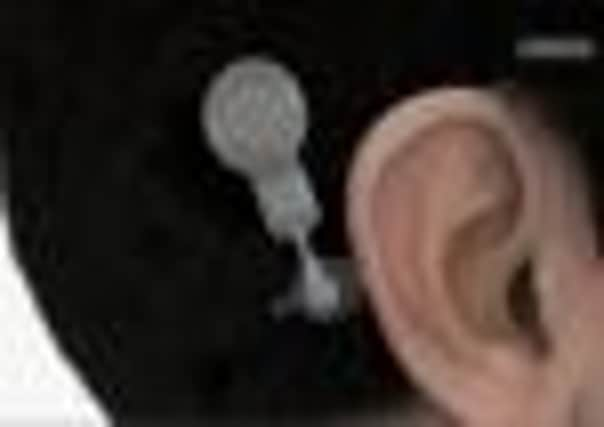First Scots patient fitted with new hearing aid


The “Bonebridge” device consists of an externally worn audio processor and a hearing implant, surgically fitted under the skin to the bone structure behind the ear.
Karen Thomson, 42, a mother of two from Brechin who works at Stracathro Hospital in Angus, was the first patient in Scotland to be fitted with the Bonebridge device at Ninewells Hospital in Dundee in December.
Advertisement
Hide AdAdvertisement
Hide AdAnd today, as she visited audiology staff at the city’s Kings Cross health centre for a check-up, she told how her life had been transformed after being fitted with the pioneering hearing aid, designed for patients with mild to moderate hearing losses.
Mrs Thomson explained that she had attended numerous clinics and appointments over the years for recurrent ear infections, which resulted in a conductive hearing loss in both her ears where sounds are heard at a much lower levels.
She struggled to hear what was being said both at work and at home and needed to turn up the volume of the TV and radio to such a high level that her family would complain about it.
Mrs Thomson said: “I have suffered so many ear problems over the years and was unable to tolerate hearing aids owing to recurrent infection. Other treatments included antibiotics, steroids, ear drops and grommets that help to equalise the pressure in the middle ear, but these were only ever treating my symptoms rather than finding a more permanent solution.
“I was delighted when it was suggested to me that I might be a candidate for this new technology and even more so to be the first person in Scotland to be switched on – I feel quite privileged.”
She continued: “I can now lead a normal life and be part of the conversation instead of having to ask people to repeat themselves all the time. It was so frustrating for me and my husband Kevin, who must have been fed up constantly having to repeat himself.”
Mrs Thomson added: “My children, 16 year old Callum and 11 year old Logan have also been very patient with me. It is such an uncomfortable thing to have to live with and can be socially isolating, which many people don’t realise. I am so grateful to the surgical team at Ninewells and the Audiology team at Kings Cross.”
Samantha Batty, the head of Service for Audiology at NHS Tayside, explained that conductive hearing loss was often be caused by malformations of the external or middle ear or by severe middle ear infections, resulting in sounds being heard at a much quieter level
Advertisement
Hide AdAdvertisement
Hide AdShe said: “NHS Tayside is at the forefront of embracing new technology in the field of audiology and this is yet another example of this.
“Only last year Ninewells had the first person in Scotland to be fitted with a ‘Vibrant Soundbrige’ hearing device – an implant that operates not by bone conduction but by mimicking the function of the middle ear bones - and which is suitable for higher levels of hearing loss.
“The Bonebridge is not suitable for all patients with mild to moderate hearing losses as current hearing aids are adequate for most individuals. However, for those who do fit the criteria to have one fitted it will improve their quality of life considerably.”
The Bonebridge device can also used to treat individuals with mixed hearing losses, and single sided deafness.
A spokeswoman for NHS Tayside said: “ A mixed hearing loss is a combination of conductive and sensorineural hearing losses. Sensorineural hearing loss is usually associated with deterioration of the cells in the inner ear and can be a result of ageing or noise trauma.
Sensorineural hearing loss not only changes ability to hear quiet sounds, but it also reduces the quality of the sound that is heard, meaning individuals can often struggle to understand speech.
Single sided deafness is the complete failure of the hearing function on one side and patients have difficulties hearing conversation, understanding speech in noisy surroundings and determining where sounds are coming from.”
• The Bonebridge device enables sound to be transmitted directly to the inner ear by bone conduction and can be used to benefit patients in whom sound cannot be transferred to the inner ear via the natural path.
Advertisement
Hide AdAdvertisement
Hide Ad• The system consists of an externally worn audio processor and an implant. The audio processor, which is held in place directly above the implant by magnetic attraction, records the sound and converts it into signals which are then transferred through the skin to the implant.
• The implant is embedded in the temporal bone and converts the signals received into mechanical vibrations, that are then transmitted as impulses to the surrounding bone and auditory nerve of the inner ear, similar to the natural hearing process.